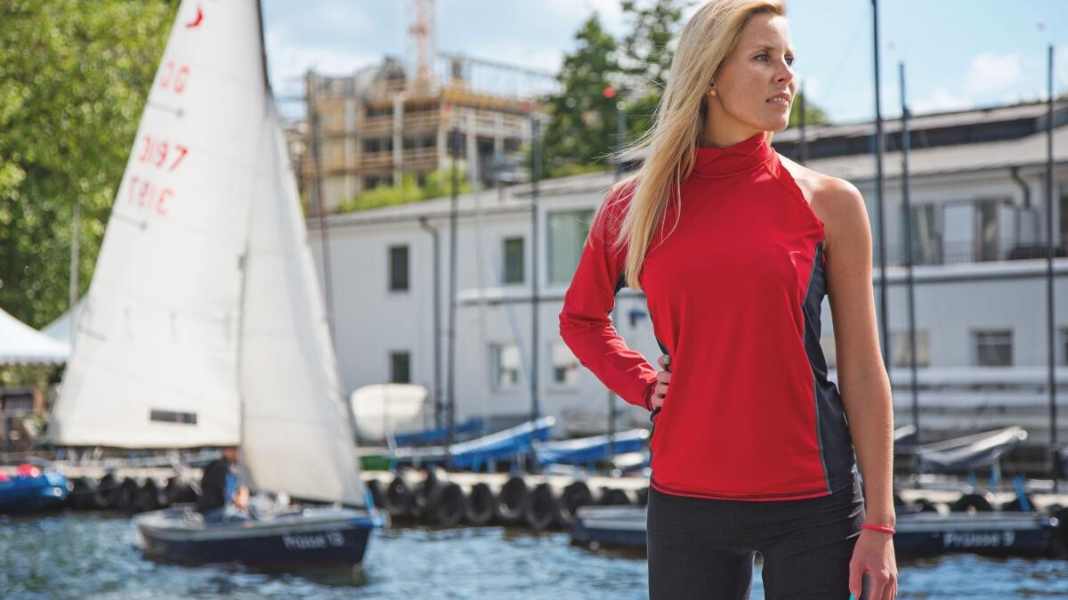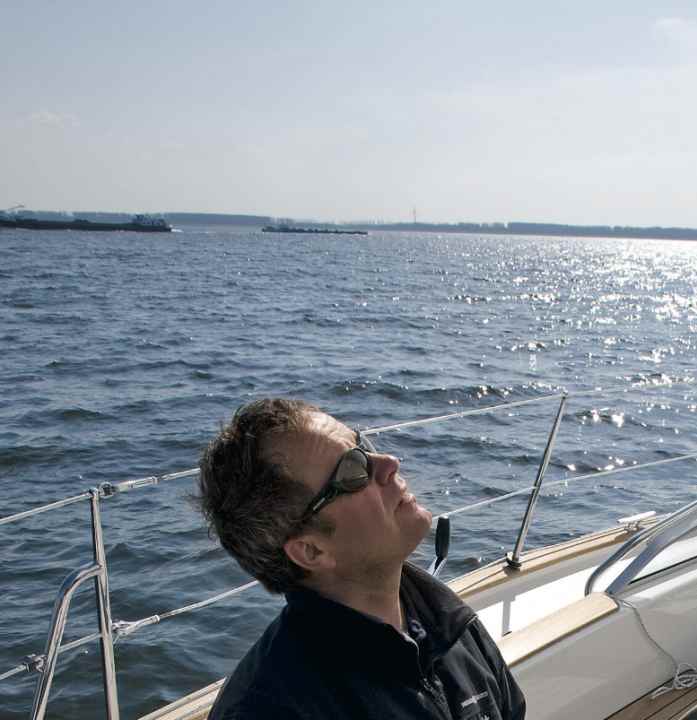
Any exposure to ultraviolet radiation - UV for short - damages the skin. Sunburns in particular put a strain on the so-called UV lifetime accountExperts refer to this effect as "cumulative sun exposure". Every minute that the skin is exposed to sunlight is stored in this account, and the consequences can add up over the course of a lifetime to skin cancer.
As a rule of thumb, the denser the fabric of a garment is woven, the less UV radiation reaches the skin
Water sports enthusiasts are particularly exposed to the sun, as it is not only out of the blue that danger threatens: the water surface also reflects large parts of the incident radiation; skiers are familiar with this phenomenon from snow. The result is usually severe sunburn, even on parts of the body that you thought were protected. This makes it all the more obvious, indeed necessary, to take precautions. The easiest way to protect yourself from sunburn is to Clothing with integrated UV protection. Their quality can be assessed quite well at the time of purchase. With the Test of our sister magazine YACHT, it was hardly possible to measure the protective effect of some shirts. In some cases, the advertised good UV protection was simply not there, advertising and truth were miles apart. This is particularly important for buyers due to the sometimes high prices annoying.
This is what the UPF and SPF factors stand for
However, you should never on clothes alone leave. Ideally, you should protect yourself with clothing and sun cream for all the areas that the fabric does not cover, such as the face, neck and hands. The effect of both protectors is stated to be similar: for sun cream with the Sun protection factor SPF (Sun Protection Factor), for clothing with the UV protection factor UPF (UV Protection Factor). The UPF is quantified in a decadal system: 10, 20, 30 and so on. It indicates how much longer a person can stay in the sun without damage compared to unprotected exposure. How long you can be exposed to the sun without protection also depends on your skin type.
A person with particularly light-coloured, sensitive skin can only spend about ten minutes in the blazing sun without protection. Thanks to special clothing with UPF 50, this period can be extended to 500 minutes, i.e. more than eight hours. It is almost impossible to achieve the same level of protection with cream as with protective clothing, as the amount applied is never evenly distributed.
Did you know? Even when the sky is overcast, around 80 per cent of UV radiation still penetrates the clouds, making sunburn all the more surprising. Around 20 per cent of the original UV radiation is reflected by the surface of the water.
Protect your eyes from UV radiation!
While hardly any skier would forget to put on sunglasses, the skier's eye all too often wanders unprotected towards the horizon, especially on supposedly less sunny days. The UV rays reflected by the water can also cause damage. The dangerous, permanent damage to the lens of the eye and the retina is initially painless and only becomes noticeable over years. The clouding of the lens, known to many people as "Cataract" (cataract) The onset of this condition at an advanced age leads to a gradual loss of visual acuity and an increasing sensitivity to glare, which can be explained by the diffuse refraction of light in the anterior segment of the eye. Exaggerated panic is not appropriate, but a Sunglasses with good UV protection is and remains a must for every cruise.

Especially Children's eyes are sensitive to sunlight. Because the lens of the eye is not yet fully developed, it is not yet able to filter UV radiation as well. In children under the age of ten, up to 75 per cent of UV radiation therefore reaches the retina, where it can cause irreversible damage. Responsible parents should therefore also ensure that their children wear high-quality sun protection for their eyes, which should also be made of shatterproof plastic to prevent injuries.
Many users of sunglasses confuse the particularly medically relevant UV protection with the noticeable glare protection. The latter is directly related to the tinting of the lenses, whereas UV protection is invisible to the user. Even with 100 per cent UV protection, the eyes may be dazzled if the tint is too weak. When used on reflective surfaces such as water (20 per cent reflection) or light-coloured sand (beach), sufficient tinting of the sunglasses is therefore another important selection criterion in addition to UV protection.
The colour of the lenses is primarily a matter of taste and does not correlate with the degree of UV protection. However, brown, grey and green lenses distort colours the least, so they should be the first choice.
8 tips against sunburn

- Avoid the midday sun (UV-B radiation).
- Use a Sun protection cream, which is at least "medium" to "highly effective" in both the UV-A and UV-B ranges (from protection factor 25). Ideal: liposomal lotions such as Daylong ultra - extremely water-resistant and non-greasy.
- Always use a sufficient dose of cream. The protection factor stated on the packaging is only achieved if you apply two milligrams of sunscreen per square centimetre of skin to be protected. Rule of thumb: a good two finger-lengths from the tube for each face/neck/head, each arm, décolleté/chest, stomach, each upper and lower leg, upper and lower back.
- People with fair skin (skin type 1-2), recreational boaters in the Mediterranean or in tropical waters and patients with skin reactions and diseases that can be caused or worsened by UV radiation/sunlight should use a "very high" protection medical sunscreen. Further information is available here. Such diseases can be: polymorphic light dermatosis, Mallorca acne, lupus erythematosus, skin cancer or early forms such as actinic keratoses.
- Apply the sunscreen about 20 minutes before sun exposure.
- Also apply cream to frequently neglected areas (e.g. neck, ears, hairless head, back of hands). And don't forget your lips. Actinica is the only medical product with proven efficacy in the prevention of various forms of light skin cancer.
- Re-cream. Physical activity such as bathing, mechanical friction caused by clothing or sweating can reduce the sun protection function. The only thing that helps then is to reapply sun cream.
- Wearing specific items of clothing can also protect you from the sun's rays.
Treating sunburn correctly
To treat sunburn properly and alleviate the pain and discomfort, you should follow the steps below:
- Cool and soothe: Cool the affected areas of skin by placing a cold, damp cloth or cool pack (wrapped in a towel) on the burnt areas. You can also shower or bathe with lukewarm - not hot - water to cool the skin.
- Moisturising care: After cooling the skin, use a moisturising lotion or aloe vera gel to soothe and moisturise your skin. Aloe vera has anti-inflammatory and healing properties and is excellent for treating sunburn. Make sure that the lotion does not contain any fragrances or alcohol, as these can further irritate the skin.
- Pain relief: If necessary, take over-the-counter painkillers such as ibuprofen or paracetamol to reduce swelling and pain. Follow the instructions on the packaging and speak to your doctor or pharmacist if you have any concerns.
- Drink enough: Sunburn can cause your body to consume more fluids to repair the burnt skin. Make sure you drink enough water or other non-alcoholic liquids to prevent dehydration.
- Protection from further sunlight: Avoid direct sunlight on the burnt areas of skin until they are completely healed. Wear protective clothing such as long-sleeved shirts, hats and sunglasses.
- Bubble formation: If your skin blisters, try not to open or scratch it, as this can increase the risk of infection. Once the blisters have burst on their own, you can gently clean the skin with water and mild soap and use a sterile dressing to protect it.
If the sunburn is extremely painful, forms large blisters or has symptoms such as fever, chills, nausea, dizziness or headaches, consult a doctor immediately. In such cases, more intensive medical treatment may be required.

